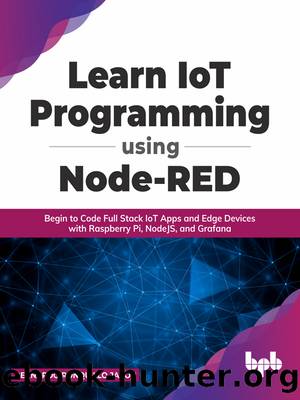Learn IoT Programming Using Node-RED: Begin to Code Full Stack IoT Apps and Edge Devices with Raspberry Pi, NodeJS and Grafana by Bernardo Ronquillo Japón

Author:Bernardo Ronquillo Japón [Japón, Bernardo Ronquillo]
Language: eng
Format: epub
Publisher: BPB Publications
Published: 2022-08-15T00:00:00+00:00
Data generation: for example, the physical sensor is not working properly; sometimes the messages are delivered every 2 seconds, and when failing, a message might be delivered 5 seconds after the previous one.
Data transmission: in the real-time layer provided by Pusher. If this service were not in a healthy state (for example, many different users overloading Pusher servers), we could see larger differences in the interval lengths, in the order of the emission rate (2 seconds).
So, it should be considered as a health indicator of our application. We will consider that the service is healthy if the interval lengths are at least one order of magnitude lower than the emission rate, i.e., 0.2 seconds.
To finish this subsection, let's recap putting together these three functionalities. Since they share the same input, the Pusher in node, we can include them in a single flow to achieve a more compact code. The result is shown in the following figure:
Download
This site does not store any files on its server. We only index and link to content provided by other sites. Please contact the content providers to delete copyright contents if any and email us, we'll remove relevant links or contents immediately.
Embedded Programming with Modern C++ Cookbook by Igor Viarheichyk(4091)
Linux Device Driver Development Cookbook by Rodolfo Giometti(4022)
Implementing Cellular IoT Solutions for Digital Transformation by Dennis McCain(4006)
Embedded Linux Development Using Yocto Project - Third Edition by Otavio Salvador & Daiane Angolini(3869)
TinyML Cookbook by Gian Marco Iodice(3769)
Simplifying 3D Printing with OpenSCAD by Colin Dow(2904)
TinyML Cookbook by Gian Marco Iodice & Ronan Naughton(2659)
Fusion 360 for Makers by Lydia Sloan Cline(2308)
Networking A Beginner's Guide by Bruce Hallberg(2290)
Hands-On Linux for Architects by Denis Salamanca(2132)
Computers For Seniors For Dummies by Nancy C. Muir(2106)
But How Do It Know? by J. Clark Scott(2079)
Raspberry Pi and MQTT Essentials by Dhairya Parikh(2040)
Arduino Project Handbook, Volume 2: 25 Simple Electronics Projects for Beginners by Geddes Mark(1999)
9781803246888-ENHANCING DEEP LEARNING WITH BAYESIAN INFERENCE by Unknown(1970)
Hack and HHVM by Owen Yamauchi(1956)
31 Days Before Your CompTIA A+ Exams (Shanette Luellen's Library) by Benjamin Patrick Conry(1922)
Hands-On Internet of Things with MQTT by Tim Pulver(1828)
MicroPython Projects by Jacob Beningo(1818)
